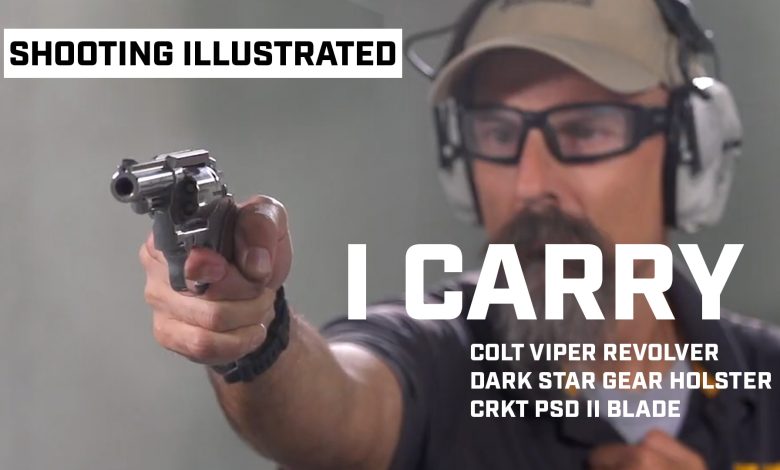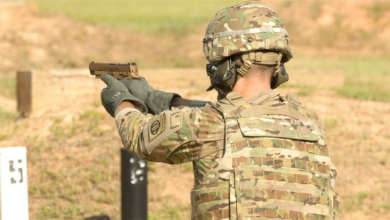I Carry: Colt Viper .357 Magnum Revolver in a Dark Star Gear Holster

Firearm: Colt Viper (MSRP: $999)
Colt continues to revamp its “snake” line of revolvers with the Viper, which joins the Cobra, King Cobra, Python and Anaconda in the storied manufacturer’s current product line. Offering both 3- and 4.25-inch barrels, the Viper is chambered in .357 Magnum and comes with attractive walnut grips, fixed sights and a rugged stainless finish. With the 3-inch variant we have in today’s kit, it’s about the perfect set-up for a defensive revolver.
Chambered in .357 Magnum, one of the big advantages of the fighting revolver is the breadth of ammunition availability. Since the Viper does not rely on recoil to operate, reliability is unaffected by ammunition choice, meaning a wider variety of projectiles for different functions can be loaded and fired. For example, for those who live in areas with venomous snakes, shotshells can be loaded into a revolver without turning it into a single-shot device. And yes, there’s more than a little irony in presenting the Colt Viper as an anti-snake measure.
As far as everyday carry, the Viper weighs 26.9 ounces and measures 8 inches long, 5 inches tall and 1.4 inches wide. This puts it pretty close in size and weight to a Glock G19 (23.6 ounces, 7.4 inches long, 5 inches tall and 1.3 inches wide), which is certainly a reasonable size for concealed carry. There’s no getting around the discrepancy in capacity, of course; the Viper carries six rounds total to the Glock’s 16. While .357 Magnum is certainly more powerful than 9mm, most will run .38 Special in the Viper for better recoil control, making the difference in power negligible. In the end, it comes down to personal preference and familiarity.
If you’re a fan of the revolver as your personal-defense firearm, Colt’s new Viper is a superlative choice. There are several excellent aftermarket grip options available such as the Hogue Monogrip rubber grip and hardwood grips from Altamont that have a reduced profile to keep printing to a minimum. In the end, the ability to customize the revolver to best suit the shooter, combined with a wider variety of ammunition choices, make it worth consideration in general. In the end, though, it’s another excellent choice, and that’s always a good thing.
Holster: Dark Star Gear Apollo (MSRP: $90)
We wanted to show that the Viper could be carried in the same manner as most semi-automatic, striker-fired 9 mm handguns, so we’ve chosen Dark Star Gear’s excellent Apollo inside-the-waistband holster to carry it. Constructed of a single sheet of kydex in a taco-style configuration, the Apollo is simple, yet robust—much like the Colt Viper revolver it carries. Retention can be adjusted via a single screw, and a wing can be attached to help aid concealment if the holster is worn in the appendix position.
Available for both right- and left-handed shooters and with a variety of possible color options, the Apollo can be configured to the preferences of the individual. Numerous belt-attachment options can be chosen, such as soft loops, an RCS overhook strut, or the tuckable DCC clip on the Apollo we’ve chosen for the Viper. We have featured a number of Dark Star Gear holsters on “I Carry,” and all are quite well-made, robust and reliable.
Accessory: CRKT PSD II (MSRP: $75)
Rounding out today’s kit is the Columbia River Knife & Tool Co. PSD II pocketknife, pairing a no-nonsense assisted-opening knife with the Colt Viper. The PSD II features a 3-inch-long, AUS10 steel blade that opens via an assisted flipper mechanism using CRKT’s IKBS ball-bearing system. Scales are G10 with a coyote brown finish, and the blade wears a black EDP finish for corrosion resistance.
There are a bunch of nice touches on the PSD II, like the ability to carry in either the tip-up or tip-down configuration depending on the user’s preference. In the tip-up setup, the knife comes out of the pocket oriented for immediate use; while in tip-down some manipulation may be required to make the knife available, but the point stays well away from the fingers. Texture on the scales is excellent, while the blade has both jimping on the back and a slight groove on the front to fit the hand well.
Read the full article here







